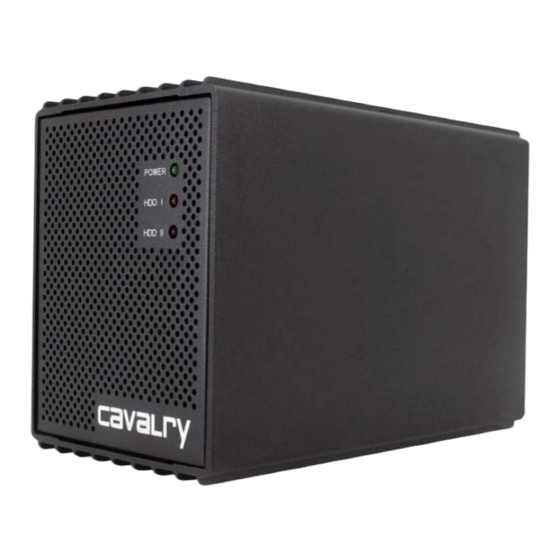Cavalry CADA-SA2 Series Buku Petunjuk - Halaman 5
Jelajahi secara online atau unduh pdf Buku Petunjuk untuk Penyimpanan Cavalry CADA-SA2 Series. Cavalry CADA-SA2 Series 10 halaman. 2-bay raid external

GETTING STARTED
DESCRIPTION OF RAID-MODES
RAID modes and terminology can be a little confusing to the un-initiated. Rather than try to explain the exact mechanisms that
underlie each mode, we will describe each one in terms of what they can do for you. Then, you can carefully choose the
appropriate mode for your application.
Normal JBOD Mode
This really isn't a RAID mode at all. JBOD simply allows you to see and use each drive separately within its bay. There is no
performance advantage to JBOD. But, it is very useful when transferring data from one drive to the next; or when you need to
error-check individual drives within your Disk Management Utility. Plus, JBOD does not change the file system the way the
other modes do. This makes it a safe bet if you are unsure of what mode you should use.
raid 0 Mode
(Striped Drives)
This is only recommended for those people who absolutely must have the absolute maximum in transfer speed and storage
capacity. This mode is easily capable of maxing the speed limit of USB 2.0 (roughly 60 MB/s). That is because RAID 0 com-
bines the speeds of both drives in tandem. Since the average hard drive can output around 60MB/s on its own, RAID 0 would
then create one super-drive with a maximum of 120 MB/s read -speeds! Consequently, the only way that the user will ever be
able to experience that ultra-high throughput speed is through a next-generation interface like USB 3.0. The problem is this: if
one drive dies, all of your data will be lost. In order to safely use RAID 0, you'll need a third separate drive in which to backup
your critical data. You will also need to verify that each disk you intend to use in this array is the exact same make and model.
raid 1 Mode
(Mirrored Drives)
This mode continuously duplicates all of the data from one drive onto a target drive of equal-size. In other words, it "mirrors"
the source drive. This is by far the preferred mode for a small RAID array. It provides security for all of your source-drive's
data in the form of a true automatic backup. The catch is that your storage capacity is limited to that of the source drive. You
will also need to verify that each disk you intend to use in this array is the exact same make and model.
Spanning Mode
This mode is very similar to RAID 0. It combines or 'concatenates' two drives into one large and seamless volume. The
benefit of Spanning mode is that you can use completely different SATA II disks of different capacity and speeds. But, there is
no performance advantage in Spanning mode. Likewise, Spanning mode is just as dangerous as RAID 0. If one drive dies, the
whole array is dead! In order to safely use Spanning mode, you'll need a third separate drive in which to backup your critical
data.
4. Remove the faceplate and insert each drive into
the logic board. Make sure each drive is resting
securely on the chassis rails. Next, verify that
each drive's SATA port is fully engaged to the
logic-board.
5. Insert all 8 drive-retainer screws to secure your
drives to the chassis.
6. Carefully re-mount the front faceplate and
enclosure-sleeve.
7. Your CADA is now ready to be RAIDed,
initialized, and formatted.
(Just a Bunch Of Disks)
CADA-SA2
3
1
CHAPTER
